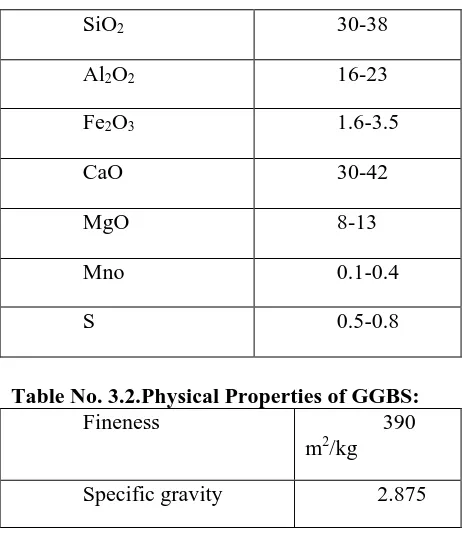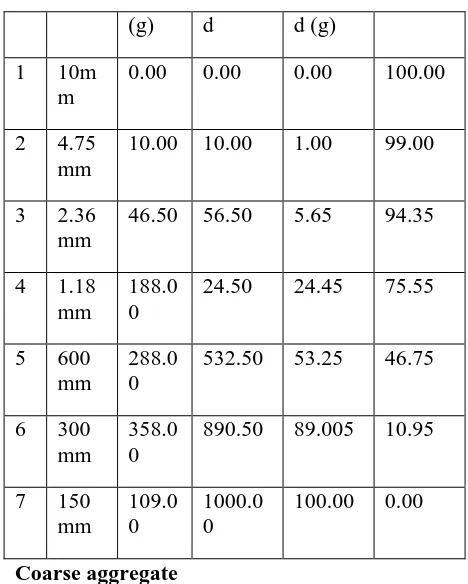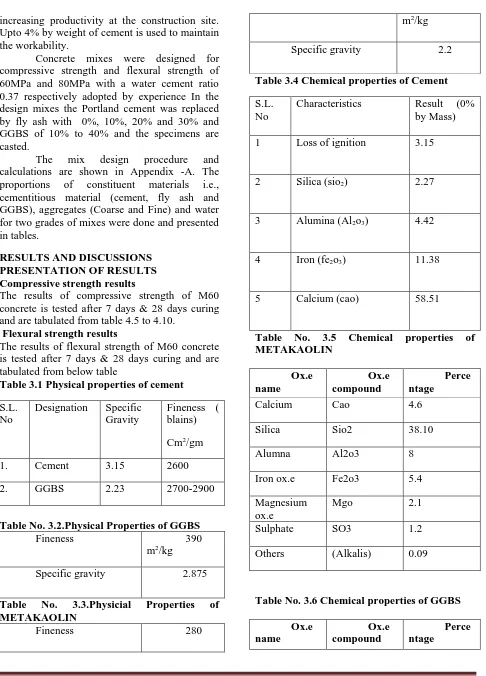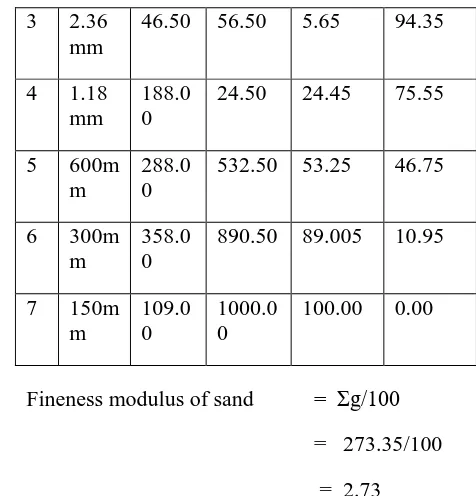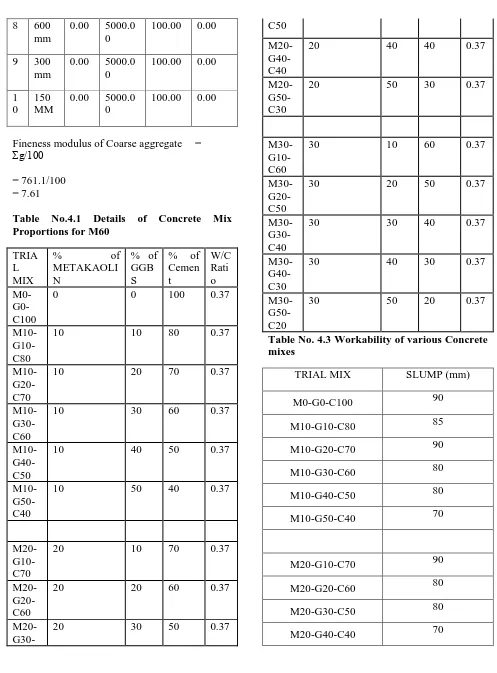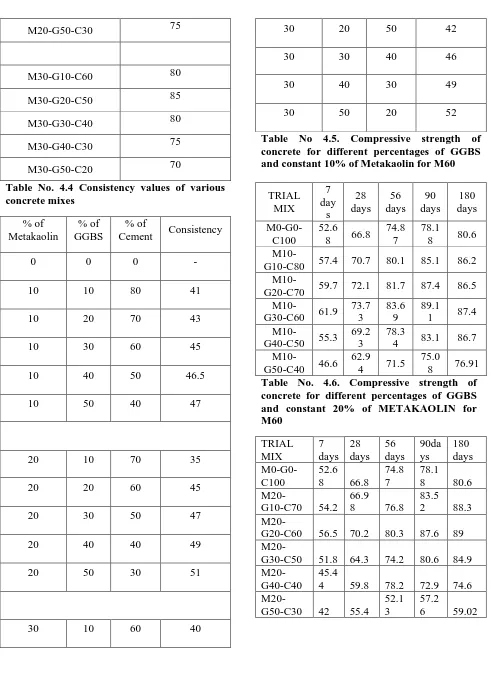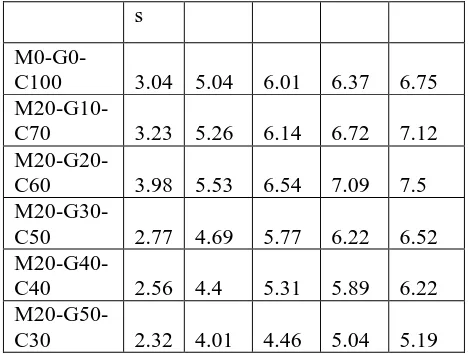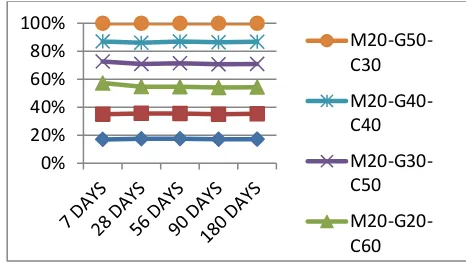Available online: https://edupediapublications.org/journals/index.php/IJR/ P a g e | 351
Experimental Study of GGBS with Metakaolin
G.Shiva Prasad1, C.Manikanta Reddy2, E.Vamshi3,
1
(Project guide, Assistant Professor, Anurag Engineering College) 2
(HOD, Assistant Professor, Anurag Engineering College) 3
(Structural Engineering, Anurag Engineering College)
Abstract-Construction industry is dominated by
new materials which are ecologically violable and feasible solution for ever growing architectural industry. Effort are in progress all over the world to develop environment friendly construction materials which minimizes the utility of natural resources and helps to decrease green house gas emissions in to the atmosphere. The green house gas releases in the atmosphere is increasing day by day due to ordinary Portland cement production. In this connection, Geopolymer is in need, where the binders used in the production of geopolymer concrete is inorganic polymers. Geopolymer concrete will be introduced as an alternative concrete which did not use any cement in its mixture and used Metakaoline and GGBS as alternative cement. NaOH and Na2SiO3 were used as activator solution. The fixed ratio of sodium silicate to sodium hydroxide is 2.5 and the concentration of sodium hydroxide is 8 Molar. The geopolymer concrete specimens are casted and tested in the laboratory for compressive strength, Split Tensile Strength and Flexural Strength for 3 Days, 7 Days and 28 days and cured at ambient temperature. This study helps in gaining
knowledge about the morophological
composition of geopolymer concrete which might result in path-breaking trends in research and construction industry. Keywords - Geopolymer Concrete, Alkali Activators, Compressive Strength, Split Tensile Strength, Flexural Strength.
INTRODUCTION
Concrete is the most widely used man-made construction material in the world. It is obtained by mixing of fine aggregates, coarse aggregates and cement with water and sometimes admixtures in required proportions. Fresh concrete or plastic concrete is freshly mixed material which can be molded into any shape hardens into a rock-like mass known as concrete. The hardening is because of chemical reaction
between water and cement, which continues for long period leading to stronger with age. The utility and elegance as well as the durability of concrete structures, built during the first half of the last century with ordinary Portland cement (OPC) and plain round bars of mild steel, the easy availability of the constituent materials (whatever may be their qualities) of concrete and the knowledge that virtually any combination of the constituents leads to a mass of concrete have bred contempt. Strength was emphasized without a thought on the durability of structures. As a consequence of the liberties taken, the durability of concrete and concrete structures is on a southward journey; a journey that seems to have gained momentum on its path to self– destruction.
1.2 High Strength Concrete
High strength concrete has been defined as a concrete which compressive strength is high compared to the regular grades of concrete. American Concrete Institute (ACI) defines a high-strength concrete as concrete that has a specified compressive strength for design of 6000psi(41MPa) or greater. Other countries also specify a maximum compressive strength, whereas the ACI definition is open-ended.
The strength of concrete primarily depends upon the cement paste and in more the strength of paste increases with the fineness of cement contents. Hence as the water cement (W/C) Ratio decreases the concrete gets higher Strength but concrete become unworkable.
Available online: https://edupediapublications.org/journals/index.php/IJR/ P a g e | 352 concrete, at the same time it is also observed that
the cost of the concrete is reducing.
The specification of high-strength concrete generally results in a true performance specification in which the performance is specified for the intended application, and the performance can be measured using a well-accepted standard test procedure. The same is not always true for a concrete whose primary requirement is durability.
Durable concrete Specifying a high-strength concrete does not ensure that a durable concrete will be achieved. In addition to requiring a minimum strength, concrete that needs to be durable must have other characteristics specified to ensure durability. In the past, durable concrete was obtained by specifying air content, minimum cement content and maximum water-cement ratio. Today, freeze-thaw resistance, abrasion resistance or any combination of these characteristics. Given that the required durability characteristics are more difficult to define than strength characteristics, specifications often use a combination of performance and prescriptive requirements, such as permeability and a maximum water-cementitious material ratio to achieve a durable concrete.
The end result may be a high-strength concrete, but this only comes as a by-product of requiring a durable concrete.
High Performance Concrete
High performance of concrete (HPC) is widely been used in recent years, not only for its increased compressive strength, and to improve durability and economic benefits, but also for its positive impact on the environment.
Cement and concrete are key components of both commercial and residential construction in worldwide; the cement and concrete industries are huge. Worldwide, cement production of 1.25 billion tons in 1991, according to the U.SBureau of mines. And now it may be more than 3.5 billion tones.
EXPERIMENTAL INVESTIGATION Introduction
The Quality of concrete can be achieved by the selection of suitable materials, cementitious
materials, admixtures, the choice of mix proportion, water cement ratio and use of proper methods of mixing, placing and curing. All these aspects depends upon the selection of materials and admixtures.
The scope of present investigation is to high strength concrete on plain concrete, concrete with replacement of varying percentages of GGBS and METAKAOLIN in different total percentages of 0%,10%,20%,30%,40% and 50% for M60 grade concrete mix.
Ground Granulated Blast Furnace Slag
Available online: https://edupediapublications.org/journals/index.php/IJR/ P a g e | 353 Fig no.1.1GGBS
CHEMICAL COMPOSITION OF GGBS
SiO2 30-38
Al2O2 16-23
Fe2O3 1.6-3.5
CaO 30-42
MgO 8-13
Mno 0.1-0.4
S 0.5-0.8
Table No. 3.2.Physical Properties of GGBS:
Fineness 390 m2/kg
Specific gravity 2.875
Metakaolin:
Metakaolin is a dehydroxylated form of the clay mineral kaolinite. Stone that are rich in kaolinite are known as china clay or kaolin, traditionally used in the manufacture of porcelain. The particle size of metakaolin is smaller than cement particles, but not as fine as silica fume.
Table No. 3.3.Physicial Properties of Metakaolin:
Fineness 280 m2/kg
Specific gravity 2.2
Fine Aggregate
Fine aggregates are materials passing through an IS sieve that is less than 4.75mm gauge. Simply the aggregates which are passing 4.75mm sieve are called as Fine Aggregates. The most important function of the fine aggregate is to provide workability and Uniformity in the mixture. The fine aggregate also helps the cement paste to hold the coarse aggregate particle in suspension.
Table 3.6 Physical properties of fine aggregate
S. No.
Property Value
1 Specific Gravity 2.74
2 Fineness Modulus 2.73
3 Bulk density Loose Compacted
14.67 kN/m3 16.04 kN/m3 4 Grading Zone –II
Table 3.7 Sieve analysis of fine aggregate
S. L N o
IS Sieve Size
Weig ht
Retai ned
Cumul ative weight retaine
Cumul ative % weight retaine
Available online: https://edupediapublications.org/journals/index.php/IJR/ P a g e | 354 (g) d d (g)
1 10m m
0.00 0.00 0.00 100.00
2 4.75 mm
10.00 10.00 1.00 99.00
3 2.36 mm
46.50 56.50 5.65 94.35
4 1.18 mm
188.0 0
24.50 24.45 75.55
5 600 mm
288.0 0
532.50 53.25 46.75
6 300 mm
358.0 0
890.50 89.005 10.95
7 150 mm
109.0 0
1000.0 0
100.00 0.00
Coarse aggregate
Coarse aggregates are materials which retains on an IS sieve 4.75mm gauge. Simply the aggregates which are retaining on 4.75mm IS sieve are called as Coarse Aggregates.
The coarse aggregate used here with having maximum size of 20mm. We used the IS 383:1970 to find out the proportion of mix of coarse aggregate, with 60% 20mm size and 40% 10mm.
Table 3.8 Physical properties of coarse aggregate
Properties Results Obtained
Specific gravity 2.74
Fineness Modulus 7.61
Table 3.9 Sieve analysis of coarse aggregate
S. L N o
Is Sieve Size
Weig ht retai ned (g)
Cumula tive weight retaine d
Cumula tive % weight retaine d (g)
Cumula tive % passing
1 80m m
0.00 0.00 0.00 100.00
2 40m m
0.00 0.00 0.00 100.00
3 20m m
3376 .50
3376.5 0
67.52 32.48
4 10m m
1385 .00
4761.0 0
95.22 4.78
5 4.8m m
169. 00
4930.0 0
98.60 1.40
6 2.4m m
70.0 0
5000.0 0
100.00 0.00
7 1.18 mm
0.00 5000.0 0
100.00 0.00
8 600 mm
0.00 5000.0 0
100.00 0.00
9 300 mm
0.00 5000.0 0
100.00 0.00
1 0
150 MM
0.00 5000.0 0
100.00 0.00
Water
General water has been used in this experimental program for mixing and curing.
Super plasticizer
The super plasticizer used in this experiment is SP430. It is manufactured by FOSROC, Bangalore.
Super Plasticizers are new class of generic materials which when added to the concrete causes increase in the workability. They consist mainly of naphthalene or melamine sulphonates, usually condensed in the presence of formaldehyde.
Available online: https://edupediapublications.org/journals/index.php/IJR/ P a g e | 355 increasing productivity at the construction site.
Upto 4% by weight of cement is used to maintain the workability.
Concrete mixes were designed for compressive strength and flexural strength of 60MPa and 80MPa with a water cement ratio 0.37 respectively adopted by experience In the design mixes the Portland cement was replaced by fly ash with 0%, 10%, 20% and 30% and GGBS of 10% to 40% and the specimens are casted.
The mix design procedure and calculations are shown in Appendix -A. The proportions of constituent materials i.e., cementitious material (cement, fly ash and GGBS), aggregates (Coarse and Fine) and water for two grades of mixes were done and presented in tables.
RESULTS AND DISCUSSIONS PRESENTATION OF RESULTS Compressive strength results
The results of compressive strength of M60 concrete is tested after 7 days & 28 days curing and are tabulated from table 4.5 to 4.10.
Flexural strength results
The results of flexural strength of M60 concrete is tested after 7 days & 28 days curing and are tabulated from below table
Table 3.1 Physical properties of cement
S.L. No
Designation Specific Gravity
Fineness ( blains)
Cm2/gm
1. Cement 3.15 2600
2. GGBS 2.23 2700-2900
Table No. 3.2.Physical Properties of GGBS
Fineness 390 m2/kg
Specific gravity 2.875
Table No. 3.3.Physicial Properties of METAKAOLIN
Fineness 280
m2/kg
Specific gravity 2.2
Table 3.4 Chemical properties of Cement
S.L. No
Characteristics Result (0% by Mass)
1 Loss of ignition 3.15
2 Silica (sio2) 2.27
3 Alumina (Al2o3) 4.42
4 Iron (fe2o3) 11.38
5 Calcium (cao) 58.51
Table No. 3.5 Chemical properties of METAKAOLIN
Ox.e name
Ox.e compound
Perce ntage
Calcium Cao 4.6
Silica Sio2 38.10
Alumna Al2o3 8
Iron ox.e Fe2o3 5.4
Magnesium ox.e
Mgo 2.1
Sulphate SO3 1.2
Others (Alkalis) 0.09
Table No. 3.6 Chemical properties of GGBS
Ox.e name
Ox.e compound
Available online: https://edupediapublications.org/journals/index.php/IJR/ P a g e | 356 Calcium Cao 36
Silica Sio2 34
Alumna Al2o3 18.5
Iron ox.e Fe2o3 2.5
Magnesium ox.e
Mgo 11.5
Sulphate SO3 0.65
Others (Alkalis) ----
Table 3.7. Properties of fine aggregate
Properties Results Obtained
Specific gravity 2.74
Fineness Modulus 2.73
Table 3.8. Properties of coarse aggregate
Properties Results Obtained
Specific gravity 2.74
Fineness Modulus 7.61
Table 3.9 Sieve analysis of Fine aggregate (Weight of sample 1000g)
S. L N o
IS Sieve Size
Weig ht
Retai ned (g)
Cumla tive weight retaine d
Cumula tive % weight retained (g)
Cumula tive % Passing
1 10m m
0.00 0.00 0.00 100.00
2 4.75 mm
10.00 10.00 1.00 99.00
3 2.36 mm
46.50 56.50 5.65 94.35
4 1.18 mm
188.0 0
24.50 24.45 75.55
5 600m m
288.0 0
532.50 53.25 46.75
6 300m m
358.0 0
890.50 89.005 10.95
7 150m m
109.0 0
1000.0 0
100.00 0.00
Fineness modulus of sand = Σg/100
= 273.35/100
= 2.73
Table 3.10. Sieve Analysis of coarse Aggregate ( Weight of sample 5000 g)
S. L N o
Is Sieve Size
Weig ht retai ned (g)
Cumula tive weight retaine d
Cumula tive % weight retaine d (g)
Cumula tive % passing
1 80m m
0.00 0.00 0.00 100.00
2 40m m
0.00 0.00 0.00 100.00
3 20m m
3376 .50
3376.5 0
67.52 32.48
4 10m m
1385 .00
4761.0 0
95.22 4.78
5 4.8m m
169. 00
4930.0 0
98.60 1.40
6 2.4m m
70.0 0
5000.0 0
100.00 0.00
7 1.18 mm
0.00 5000.0 0
Available online: https://edupediapublications.org/journals/index.php/IJR/ P a g e | 357 8 600
mm
0.00 5000.0 0
100.00 0.00
9 300 mm
0.00 5000.0 0
100.00 0.00
1 0
150 MM
0.00 5000.0 0
100.00 0.00
Fineness modulus of Coarse aggregate = Σg/100
= 761.1/100 = 7.61
Table No.4.1 Details of Concrete Mix Proportions for M60
TRIA L MIX
% of METAKAOLI N
% of GGB S
% of Cemen t
W/C Rati o
M0- G0-C100
0 0 100 0.37
M10- G10-C80
10 10 80 0.37
M10- G20-C70
10 20 70 0.37
M10- G30-C60
10 30 60 0.37
M10- G40-C50
10 40 50 0.37
M10- G50-C40
10 50 40 0.37
M20- G10-C70
20 10 70 0.37
M20- G20-C60
20 20 60 0.37
M20-
G30-20 30 50 0.37
C50
M20- G40-C40
20 40 40 0.37
M20- G50-C30
20 50 30 0.37
M30- G10-C60
30 10 60 0.37
M30- G20-C50
30 20 50 0.37
M30- G30-C40
30 30 40 0.37
M30- G40-C30
30 40 30 0.37
M30- G50-C20
30 50 20 0.37
Table No. 4.3 Workability of various Concrete mixes
TRIAL MIX SLUMP (mm)
M0-G0-C100 90
M10-G10-C80 85
M10-G20-C70 90
M10-G30-C60 80
M10-G40-C50 80
M10-G50-C40 70
M20-G10-C70 90
M20-G20-C60 80
M20-G30-C50 80
Available online: https://edupediapublications.org/journals/index.php/IJR/ P a g e | 358 M20-G50-C30 75
M30-G10-C60 80
M30-G20-C50 85
M30-G30-C40 80
M30-G40-C30 75
M30-G50-C20 70
Table No. 4.4 Consistency values of various concrete mixes
% of Metakaolin
% of GGBS
% of
Cement Consistency
0 0 0 -
10 10 80 41
10 20 70 43
10 30 60 45
10 40 50 46.5
10 50 40 47
20 10 70 35
20 20 60 45
20 30 50 47
20 40 40 49
20 50 30 51
30 10 60 40
30 20 50 42
30 30 40 46
30 40 30 49
30 50 20 52
Table No 4.5. Compressive strength of concrete for different percentages of GGBS and constant 10% of Metakaolin for M60
TRIAL MIX
7 day
s
28 days
56 days
90 days
180 days
M0-G0-C100
52.6
8 66.8 74.8
7
78.1
8 80.6
M10-G10-C80 57.4 70.7 80.1 85.1 86.2
M10-G20-C70 59.7 72.1 81.7 87.4 86.5
M10-G30-C60 61.9 73.7
3
83.6 9
89.1
1 87.4
M10-G40-C50 55.3 69.2
3
78.3
4 83.1 86.7
M10-G50-C40 46.6 62.9
4 71.5 75.0
8 76.91
Table No. 4.6. Compressive strength of concrete for different percentages of GGBS and constant 20% of METAKAOLIN for M60
TRIAL MIX
7 days
28 days
56 days
90da ys
180 days
M0-G0-C100
52.6 8 66.8
74.8 7
78.1
8 80.6
M20-G10-C70 54.2 66.9
8 76.8 83.5
2 88.3
M20-G20-C60 56.5 70.2 80.3 87.6 89
M20-G30-C50 51.8 64.3 74.2 80.6 84.9
M20-G40-C40 45.4
4 59.8 78.2 72.9 74.6
M20-G50-C30 42 55.4 52.1 3
57.2
Available online: https://edupediapublications.org/journals/index.php/IJR/ P a g e | 359
Table No. 4.7. Compressive strength of concrete for different percentages of GGBS and constant 30% of METAKAOLIN for M60
TRIAL MIX
7 days
28da ys
56da ys
90da ys
180da ys
M0-G0-C100
52.6
8 66.8 74.8 7
78.1
8 80.6
M30-G10-C60 38.8 64.2 69.9 74.2 77.3
M30-G20-C50 48.2 72.2 78 82.5 85.76
M30-G30-C40
36.0 4
59.2 3
62.9 6
66.6
8 68.57
M30-G40-C30 32 41
56.6 6
59.3 4 62
M30-G50-C20 27.1 28.7 40.1 9
53.1
6 55.8
Table No.4.8 Flexural strength of concrete for different percentages of GGBS and constant 10% of METAKOALIN for M60
MIX ID 7 days
28 days
56 days
90da ys
180 days
M0-G0-C100 3.04 5.04 6.01 6.37 6.75
M10-G10-C80 3.83 6.03 6.73 7.25 7.72
M10-G20-C70 3.59 5.81 6.58 7.06 7.47
M10-G30-C60 4.46 6.24 6.98 7.56 8.26
M10-G40-C50 3.29 5.3 6.24 6.79 7.2
M10-G50-C40 2.73 4.72 5.72 5.96 6.25
Table No. 4.9 Flexural strength of concrete for different percentages of GGBS and constant 20% of METAKAOLIN for M60
M IX ID
7 day
28 days
56 days
90 days
180 days
s
M0-G0-C100 3.04 5.04 6.01 6.37 6.75
M20-G10-C70 3.23 5.26 6.14 6.72 7.12
M20-G20-C60 3.98 5.53 6.54 7.09 7.5
M20-G30-C50 2.77 4.69 5.77 6.22 6.52
M20-G40-C40 2.56 4.4 5.31 5.89 6.22
M20-G50-C30 2.32 4.01 4.46 5.04 5.19
Table No. 4.10. Flexural strength of concrete for different percentages of GGBS and constant 30% of METAKAOLIN for M60
MIX ID 7 day s
28 days
56 days
90 days
180 days
M0-G0-C100 3.04 5.04 6.01 6.37 6.75
M30-G10-C60 2.83 4.9 5.8 6.27 6.62
M30-G20-C50 3.43 5.24 6.3 6.73 7.15
M30-G30-C40 2.59 4.1 4.78 5.26 5.62
M30-G40-C30 2.35 3.47 4.11 4.4 4.57
M30-G50-C20 2.03 2.53 3.19 3.81 4.07
FIGURES
0% 20% 40% 60% 80% 100%
M10-G50-C40
M10-G40-C50
Available online: https://edupediapublications.org/journals/index.php/IJR/ P a g e | 360 Figure No.4.1 Compressive strength for
different percentages of GGBS and constant of 10% metakaolin for M60
Figure No..4.2. Effect of Compressive strength by increasing of GGBS for constant of 20% metakaolin for M60
Figure. No.4.3. Compressive strength for different percentages of GGBS andconstant of
30% metakaolin for M60
Figure. No.4.4. Flexural strength for different percentages of GGBS and constant of 10%
metakaolin for M60
Figure. No.4.5. Effect of Flexural strength by increasing of GGBS for constant of 20%
metakaolin for M60
Figure. No.4.6. Flexural strength for different percentages of GGBS and constant of 20%
metakaolin for M60 Conclusions
Based on experimental investigations the following conclusions are drawn.
1. Cement replacement by in combination of metakaolin and adding Ground granulated blast furnace slag leads to increase in compressive strength and flexural strength up to 40% to 50% replacement for M60 grade of concrete. Beyond 50% replacement of metakaolin and ground granulated blast furnace slag compressive strength and flexural strength decreased.
2. It is observed that at 28days compressive strength and flexural strength of M60 grade concrete are increased for different combination of mix proportions .
0% 50%
100%
M20-G50-C30
M20-G40-C40
M20-G30-C50
0% 20% 40% 60% 80% 100%
M30-G50-C20
M30-G40-C30
M30-G30-C40
0% 20% 40% 60% 80% 100%
M10-G50-C40
M10-G40-C50
M10-G30-C60
0% 20% 40% 60% 80% 100%
M20-G50-C30
M20-G40-C40
M20-G30-C50
M20-G20-C60
0% 20% 40% 60% 80% 100%
M30-G50-C20
M30-G40-C30
Available online: https://edupediapublications.org/journals/index.php/IJR/ P a g e | 361 3. It is observed that at 90days compressive
strength and flexural strength of M60 grade concrete are increased.
4. It is observed that at 180days compressive strength and flexural strength of M60 grade concrete are increased.
REFERENCES
K Ganesh Babu and V. Sree Rama Kumar, "Efficiency of GGBS in Concrete-, Cement and Concrete Research, Vol. 30, 2000, 1031-1036. M. Collepardi, "Admixtures used to
enhance placing characteristics of concrete", Cement & Concrete Composite, Vol. 20, 1998, 103-112 A Oner& S Akyuz, "An experimental
study on optimum usage of GGBS for the \compressive strength of concrete", Cement & Concrete Composite, Vol. 29, 2007, 505-514.
S. Bhanja, B. Sengupta, “Modified water cement ratio law for silica fume concretes”, Cement and Concrete Research, Vol.33,2003,447-450.
K.SuvarnaLatha, M.B. Sheshagirirao, SrinivasReddy.V,(Dec, 2012)., In their paper entitled “Estimation of Ground granulated blast furnace slag (GGBS), and high volume fly ash (HVFA) strength efficiencies in concrete with age”. Published in International journal of Engineering and Advanced Technology (IJEAT)
IS 456: 2000, “Indian Standard Code of Practice for Plain and Reinforced Concrete”, Bureau of Indian Standard, New Delhi.
IS 10262: 2009 “Recommended Guidelines for Concrete Mix Design”, Bureau of Indian Standard, New Delhi. IS 383: 1970, “Specification for Coarse
Aggregate and Fine Aggregate From Natural Sources for Concrete”, Bureau of Indian Standard New Delhi.
IS 9103: 1999,” Indian Standard Concrete Admixture Specification “,Bureau of Indian Standard, New Delhi. IS 9399: 1959,” Specification For
Apparatus for Flexural Testing of Concrete “Bureau of Indian Standard, New Delhi.
IS 516: 1959,” Flexural Strength of Concrete “,Bureau of Indian Standard, New Delhi.
I.S. 9103-1999, “Specification for admixtures for concrete”. BIS
